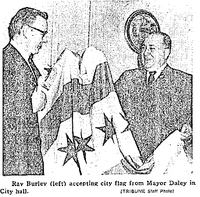Suggestion #7
Suggestions Submitted for the Guidance and Information of Contestants in the Public Competitive Contest for a Suitable Design of a Municipal Flag for the City of Chicago — Wallace Rice, 1916.
Suggestion 7.
The visibility at distances of the several colors and of the different portions of the flag itself should be taken into account in determining its proportions, rather than divisions of mathematical exactitude. In other words, it is the effect of symmetry, not the mere physical fact, which should be taken into account. The French, for example, after extensive experimentation, divide their tricolor so that the blue next the staff has thirty parts in a hundred, the white in the middle thirty-three parts, and the red in the fly thirty-seven, and thus secure the appearance of an equal division.
I suppose this explains why all the descriptions of the flag have tortured syntax — the “slightly less than a sixth” language. Rice wanted the white and blue stripes to appear to have the same width, and so they must be slightly different.
